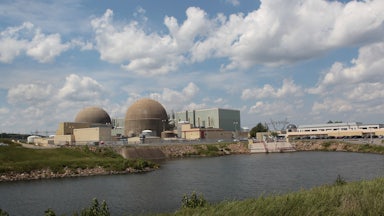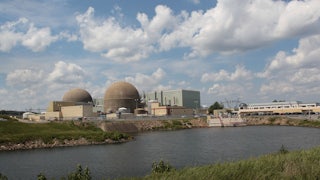Eleven years ago, as President Obama was beginning to emphasize climate change as a potential legislative priority, utility companies began strategizing to survive the new age. In June 2010, then–Duke Energy CEO Jim Rogers co-authored an op-ed in Politico with Eileen Claussen, a veteran of the Clinton administration and the founder of the Pew Center on Global Climate Change, in which the two agreed that the time for legislators, businesses, and environmentalists to take action had arrived. “If that means capping emissions from the utility sector first—so be it,” they wrote. The pair called for clear federal regulations and policies so that Duke Energy and other companies could rightfully lead on climate change. After all, the corporation was “already scheduled to retire and replace virtually all coal and other large power plants with cleaner and more efficient technologies by 2050.”
Today, in 2021, any reflection on these and other promises made by Duke Energy’s now-former chief executive should elicit alternating fits of laughter and teeth-gnashing. In the time since, the corporation essentially wrote the book on How Not to Manage an Energy Transition with a disastrous coal ash spill, only to turn around and publicly face-plant in its attempt to help construct a natural gas pipeline through Black communities and Indigenous lands. Now, as the Biden administration gears up to push climate legislation, it’s become clear that Duke Energy’s greenwashing strategy remains almost a carbon copy of the same ones Rogers pushed in his column in 2010. What is changing, though, is the world around it.
Every two years, Duke Energy updates its 15-year plan regarding its energy production. The latest update, submitted at the end of last year, proposes to double its renewable energy share to make up 14 percent of the company’s total energy generation, while gas would constitute a 31 percent share, with ambitions to actually build more gas plants in the coming decade. This plan would also include potentially operating some of its coal plants until 2049 and its gas plants well beyond that. In every sense, Duke is a coal and gas operation clinging to what it already controls and staving off renewables until it can single-handedly command that field, too.
Concerned citizens and climate groups have criticized Duke Energy’s plan updates in the past during the public comment periods operated by the North Carolina Utilities Commission. But municipal governments and companies, which as stakeholders are also able to submit comments ahead of the plan’s enactment and whose opposition is a bit harder to brush off, mostly didn’t enter the fray.
In March, a virtual public hearing scheduled for these stakeholders had to be delayed because over two dozen city and county governments and private corporations—a record, per Energy News Network—filed comments addressing Duke’s goals. The sticking point for many of the governmental entities that spoke up is the fact that over 20 local governments in North Carolina have issued some version of zero-carbon-footprint pledges in recent years. Duke’s preferred plan, meanwhile, would cut less than two-thirds of its carbon emissions by 2035.
The city of Raleigh submitted a letter urging the Utilities Commission to “hold Duke Energy accountable in early and aggressive actions.” Nicole Stewart, an at-large City Council member, told Energy News more directly that “Duke’s renewable energy grid mix of 14% is too low for what we need.” Even Google and Apple, which operate data centers and have offices in the region that rely on Duke Energy, got in on the action, writing in a joint letter that Duke’s plan relied on “an inaccurate picture of the future,” due to its overstating of the financial burden of moving to a renewable-focused system.
Watching local North Carolina governments come together to take on the energy monopoly is exciting. But Duke Energy’s blasé greenwashing tour in the face of such opposition is a reminder of how accustomed the giant has become to being believed when it issues its press releases—it doesn’t seem to think it needs to switch strategies anytime soon. Like many of its counterparts, Duke has spent the past decade sapping all meaning from the modern climate-related lexicon. If you read Duke Energy releases, such as a January item celebrating a “record-breaking year in solar for Duke Energy customers in North Carolina” (reprinted by outlets like Yahoo Finance) or a March 30 announcement of leadership reshuffling to “accelerate its clean energy transition,” you’ll get the impression that the company is serious about decarbonizing. To wit, Nasdaq on Monday noted how, after a year of paused construction due to the pandemic, utility subsidiaries like Duke Energy Florida are beginning to invest in adding hundreds of megawatts of solar power to their portfolios. Left unsaid is how this compares to its much larger ongoing investments in gas and coal.
Duke Energy, it’s important to remember, weathered both coal ash spills and the Atlantic Coast Pipeline failure and still retained its iron grip on the North Carolina energy field. This was possible largely because the company spent a century making itself so fundamental to the functionality of the state’s grid that breaking it up would require political willpower and foresight that neither the state nor federal legislatures appear to have at the moment. The corporation recognized that in order to ensure its nuclear and gas and oil operations would remain integral to the Southern power grids for decades to come, all it had to do was stall through the Obama years and pray for at least one term of anti-environmentalist Republican rule—which it did with aplomb. Breaking this company’s hold on multiple states’ politics, and forcing it toward a more realistic plan of coal shutdown and decreased natural gas portfolio, is not going to be easy.
The good news is that local governments are starting to come around. The days of Duke Energy press releases being gobbled up by city councillors and obliging private companies seem to be coming to an end. The hope should be that, as with Duke’s coal plants, that end comes sooner rather than later.








